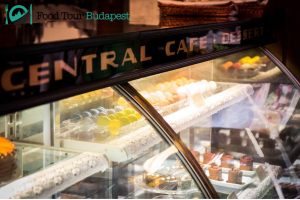
To have a whole picture of the Hungarian gastronomy you cannot leave out visiting at least one confectionary shop and taste one (or some) of the fantastic Hungarian cakes. Rákóczi túrós, Dobos torta, Eszterházy torta, zserbó, krémes, Rigó Jancsi, or Somlói galuska, all have their own story.
Let’s learn more about these great delights of the Hungarian culinary art.
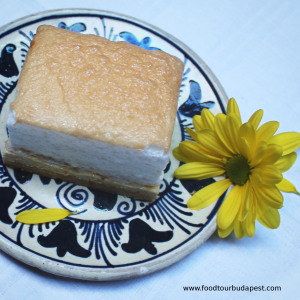
Rákóczi Túrós
Rákóczi János, pastry chef, created this cake for the 1958 Expo in Brussels. His intention was to create a cake, that is a great example of the traditional Hungarian pies, in a modern way. The base of the Rákóczi Túrós is a thin buttery pastry dough, or shortcrust pastry, that is followed by sweet curd cheese, and topped with meringue grid, the holes filled with apricot jam. Another way of building up the cake is to cover the curd cheese layer with the apricot jam, and top with the sweetened meringue (as on the picture). A lovely great example of the worthily popular sweet curd cheese in the Hungarian cakes and desserts!
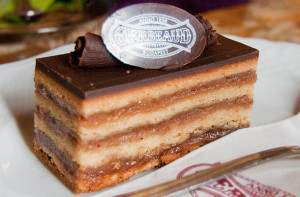
Zserbó
This cake is the ultimate dessert for the Christmas and Easter holidays in the Hungarian families. The perfect zserbó is made of four layers of thin pastry, spread with (preferably home made) apricot jam, and ground walnut, and covered with fine chocolate glaze. Zserbó is the creation of Gerbaud Emil, who took over the ownership of the current Gerbaud Coffee House and Confectionary, and besides the cake, he created bonbon meggy (bonbon with rum cherry filling), and macskanyelv (cat’s tongue) chocolate bar.
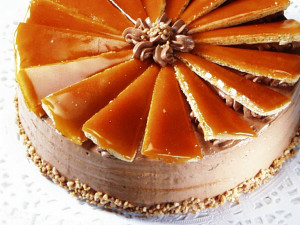
Dobos Cake
The most famous Hungarian cake is, without any doubt, the Dobos cake, created by Dobos C. József, for the 1885 National Exhibition in Budapest. Franz Joseph and his beloved Sissy were among the first people to taste this invention of the Hungarian confectioner. The six layered cake was made from a special sponge cake, with chocolate flavored butter cream between the layers, and caramel topping. At the time of the heavy cooked cream cake fillings, and the lack of refrigeration, this cake was a real invention! The butter cream filling provided the possibility for this cake to last longer, in other words: it did not go bad so quickly, and that was highly appreciated at the time. The original recipe was kept secret by Dobos C. József, it follows that more than a hundred fake Dobos cake recipes existed at the time. Before his death, he shared the original recipe with the confectioners, so anyone can enjoy a real Dobos cake throughout Hungary!
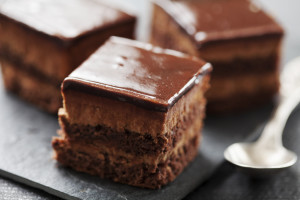
Rigó Jancsi
The traditional chocolate mousse cake was named after Rigó Jancsi, a handsome gipsy violinist. He met an American millionaire’s daughter, Clara Ward-Chimay in 1896, during a performance, who, by the way, was the wife of a Belgian prince. As the romance cought on fire, the lovers ran away together, and they wandered around the world for eight years. A confectioner who witnessed the blooming romance, named his chocolate sponge cake filled with chocolate mousse, and rich chocolate glaze topping, after Rigó Jancsi. Unfortunately the love story does not have a happy ending, but the cake became extremely popular, and it is today.
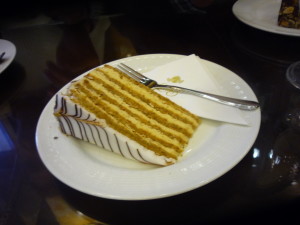
Eszterházy cake
“Eszterházy” is a family name for a Hungarian-Austrian noble family. One of the dynasty’s member, Prince Paul III Eszterházy de Galántha (1786-1866) inspired the Hungarian confectioners to create this marvelous cake and name it after him. Eszterházy cake was created in the late 18s, and quickly became very popular in the area of the Austro-Hungarian Monarchy. The cake consists of 5-7 layers of almond (today rather walnut) meringue dough layers, and vanilla or cognac flavored butter cream between them. The top is covered with fondant glaze, and decorated with chocolate stripe pattern.
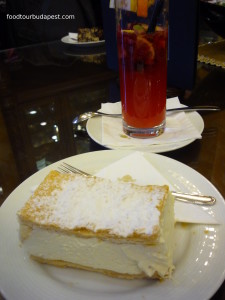
Krémes
Krémes probably originates from Austria, and definitely became very popular in the territory of the Austro-Hungarian Empire, and the Eastern European countries. It is mentioned in several Hungarian cookbooks (Zilahy Ágnes, Dobos C. József) at the end of the 19th century, but had basic changes in the cream and pastry in the last 130 years. Crispy and very thin layers of bottom and top, filled with fluffy, thick creamy filling. Easy and fantastic as it is! Almost any confectionary shop offers their own version.
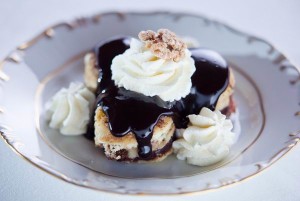
Somlói Galuska
The ultimate Hungarian favorite. Plain, chocolate and walnut flavored sponge cake, vanilla cream, walnut and chocolate sauce, topped with whipped cream. No wonder that the cake (or rather dessert) won several prizes on the Brussels Expo in 1958. The idea of the cake comes from the Gundel Restaurant’s head waiter, Gollerits Károly, and was effectuated by Szőcs Béla, confectioner. named after the Somlyó hill in Fót.
Take an advantage on tasting these fabulous cakes yourselves, several cafés (Café New York, Café Central, Gerbaud) and confectionary shops (Szamos, Daubner) have a very nice selection of the classic Hungarian cakes.
We also taste some of the cakes on our Coffee Houses walking tour!
